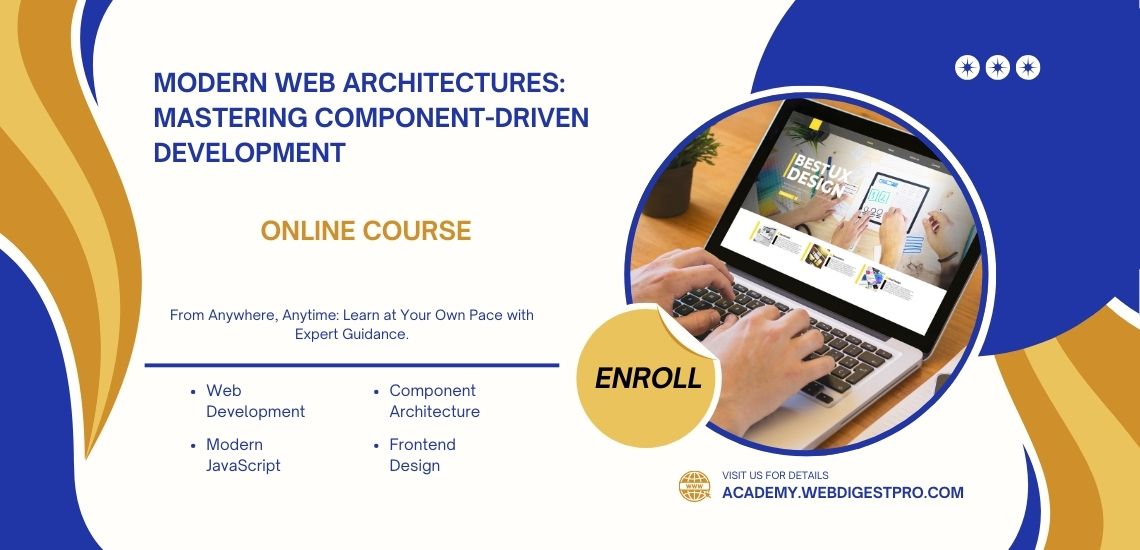
Course Title: Modern Web Architectures: Mastering Component-Driven Development
Course Overview:
This course provides an in-depth exploration of Component-Driven Development (CDD), a revolutionary approach to building modern web applications. By understanding and applying CDD principles, you’ll learn how to create modular, reusable, and maintainable components that form the foundation of scalable and efficient web applications. This course is ideal for web developers looking to enhance their skills with modern frontend development practices using frameworks like React, Vue.js, and Svelte.
Module 1: Introduction to Component-Driven Development
- Lesson 1.1: Evolution of Web Architectures
- Overview of traditional web development approaches.
- Transition from monolithic architectures to modular systems.
- The rise of Component-Driven Development.
- Lesson 1.2: Understanding Component-Driven Development (CDD)
- What is CDD?
- Key characteristics: Encapsulation, Reusability, Independence, and Composability.
- Comparison with traditional development methods.
Module 2: Core Concepts of CDD
- Lesson 2.1: Encapsulation in Components
- Understanding encapsulation in HTML, CSS, and JavaScript.
- Benefits of encapsulated components in modern frameworks.
- Hands-on: Building a fully encapsulated button component.
- Lesson 2.2: Reusability of Components
- Defining and identifying reusable components.
- How reusability accelerates development and ensures consistency.
- Hands-on: Creating reusable form controls and navigation elements.
- Lesson 2.3: Independence and Composability
- Developing and testing components in isolation.
- Strategies for composing complex UIs from simple components.
- Hands-on: Composing a dashboard using independent, reusable components.
Module 3: Implementing CDD in Modern Frameworks
- Lesson 3.1: Component-Driven Development in React
- Overview of React’s component architecture.
- Functional components and hooks.
- Hands-on: Building a stateful component with React.
- Lesson 3.2: CDD in Vue.js
- Single-File Components (SFCs) and their role in Vue.js.
- Managing state and lifecycle within Vue components.
- Hands-on: Creating and testing a Vue.js component.
- Lesson 3.3: Exploring Svelte’s Approach to CDD
- How Svelte compiles components into efficient code.
- Benefits of Svelte’s approach for performance and scalability.
- Hands-on: Building a Svelte component and analyzing its compiled output.
Module 4: Advanced Benefits of CDD
- Lesson 4.1: Enhancing Development Speed and Consistency with Reusable Components
- Case studies on cross-project component sharing.
- Tools and platforms for managing component libraries (e.g., Bit, npm).
- Hands-on: Setting up a shared component library.
- Lesson 4.2: Simplifying Maintenance with Component-Driven Development
- Best practices for maintaining a component-based codebase.
- Debugging techniques with React DevTools and Vue Devtools.
- Hands-on: Refactoring an existing component to improve maintainability.
Module 5: Scaling Applications with CDD
- Lesson 5.1: Modular Growth and Load Management
- Strategies for scaling applications using lazy loading and dynamic imports.
- Hands-on: Implementing code splitting in a React or Vue.js application.
- Lesson 5.2: Decoupled Architectures and Micro Frontends
- Understanding micro frontend architecture.
- How to implement micro frontends in a component-driven ecosystem.
- Hands-on: Building a micro frontend using multiple components.
Module 6: Testability in Component-Driven Development
- Lesson 6.1: Unit Testing Components
- Importance of testing in isolation.
- Tools and techniques for unit testing (Jest, Mocha).
- Hands-on: Writing and running unit tests for React and Vue components.
- Lesson 6.2: Integration and End-to-End Testing
- How to test component interactions and user workflows.
- Tools for E2E testing (Cypress, Selenium).
- Hands-on: Creating integration tests for a component-driven application.
- Lesson 6.3: Visual Regression Testing
- Introduction to visual regression testing.
- Tools for automating visual testing (Percy, Chromatic).
- Hands-on: Setting up and running visual regression tests.
Module 7: Building and Maintaining a Component-Driven Project
- Lesson 7.1: Designing Components with Reusability and Encapsulation
- Identifying potential reusable components.
- Best practices for encapsulation.
- Hands-on: Designing a reusable, encapsulated component from scratch.
- Lesson 7.2: Creating and Documenting a Component Library
- Organizing components into a structured library.
- Documenting components with tools like Storybook.
- Hands-on: Building and documenting a component library.
- Lesson 7.3: Hierarchical Structuring and Continuous Integration
- Organizing components into a clear hierarchy.
- Integrating component testing into CI/CD pipelines.
- Hands-on: Implementing CI/CD for a component-driven project.
Conclusion: The Future of Web Development with CDD
- Lesson 8.1: The Evolution and Future Trends in CDD
- Current trends in web development related to CDD.
- Future directions and innovations.
- Lesson 8.2: Embracing CDD for Modern Web Development
- Key takeaways and best practices.
- Final project: Develop a small, component-driven web application from scratch.
Final Project:
Students will apply the concepts learned throughout the course to design, develop, and document a small web application using Component-Driven Development principles. The final project will be peer-reviewed and presented as a portfolio piece.
Learning Outcomes:
By the end of this course, students will:
- Understand the principles and benefits of Component-Driven Development.
- Be able to design and develop reusable, maintainable, and scalable components.
- Gain hands-on experience with modern frameworks like React, Vue.js, and Svelte.
- Learn advanced techniques for testing and scaling component-driven applications.
- Build and document a component library to streamline development across projects.
Course Materials:
-
- Course textbook: “Component-Driven Development with Modern Frameworks”
- Software: Node.js, React, Vue.js, Svelte, Jest, Cypress, Storybook
- Access to online resources, tutorials, and forums for collaborative learning.

